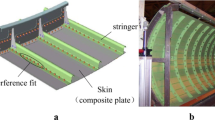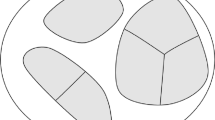Abstract
Compliant structures, e.g. automobile body panel and airplane wing box are widely used. A compliant structure consists of one or more flexible parts, and these parts share the mating features among them. Because of process-induced deformation and part-to-part variations, external forces are applied during the assembly process and the parts are deformed. As a result, the final assembly is pre-stressed and its geometrical shape may deviate from the designed shape. Therefore, the assembly variation and residual stress need to be analysed in order to evaluate the structure performance. In this study, a new approach based on response surface methodology is developed. A number of organised virtual experiments are conducted with the aid of finite element analysis and regression models are fitted to the resulting data. These regression models relate part variations to assembly variation and residual stress. Monte Carlo simulation can be conveniently done using these simple regression models. The effectiveness of this method was illustrated using a composite–metal assembly. It is shown that the method presented in this paper provides a practical and reliable solution to the analysis of compliant structures.
Similar content being viewed by others
References
Ouyang PR et al (2008) Micro-motion devices technology: the state of arts review. J Adv Manuf Technol 38(5–6):463–478
Ouyang PR, Zhang WJ, and Gupta MM (2005) Design of a new compliant mechanical amplifier, in 2005 ASME Design Engineering Technical Conference. Long Beach, CA, USA
Liu SC, Hu SJ (1997) Variation simulation for deformable sheet metal assemblies using finite element methods. ASME J Manuf Sci Eng 119(3):368–374
Liu SC, Hu SJ, Woo TC (1996) Tolerance analysis for sheet metal assemblies. ASME J Mech Des 118(1):62–67
Camelio J, Hu SJ, Ceglarek D (2003) Modeling variation propagation of muti-station assembly system with compliant parts. ASME J Mech Des 125(4):673–681
Chase KW, Greenwood WH (1988) Design issues in mechanical tolerance analysis. Manuf Rev ASME 1(1):50–59
Dong Z, Hu W, Xue D (1994) New production cost-tolerance models for tolerance synthesis. ASME J Eng Ind 116:119–206
Lee B et al (2007) Variation analysis of three dimensional non-rigid assemblies, in Proceedings of the 2007 IEEE International Symposium on Assembly and Manufacturing. IEEE, Ann Arbor, Michigan, USA. p. 13–18
Tonks MR, Chase KW, Smith C (2007) In: Davidson JK (ed) Predicting deformation of compliant assemblies using covariant statistical tolerance analysis, in models for computer aided tolerancing in design and manufacturing. Springer, Netherlands, pp 321–330
Montgomery DC (2009) Design and analysis of experiments, 7th edn. Wiley, New York
Author information
Authors and Affiliations
Corresponding author
Rights and permissions
About this article
Cite this article
Dong, C., Kang, L. Deformation and stress of a composite–metal assembly. Int J Adv Manuf Technol 61, 1035–1042 (2012). https://doi.org/10.1007/s00170-011-3757-9
Received:
Accepted:
Published:
Issue Date:
DOI: https://doi.org/10.1007/s00170-011-3757-9




